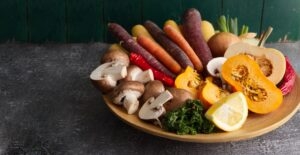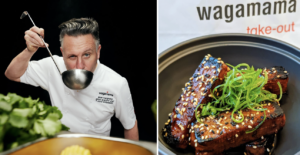Interview
Veganuary: Top chefs share how to turn their favourite dishes vegan
20 Jan 2023
6m
However much you love a meaty burger or a steak, the consensus is clear across the board – we all need to be eating a few more vegan meals for the good of the planet.
For those who aren’t experienced in the world of plant-based cooking, this might feel like a somewhat daunting prospect, and we wouldn’t blame you for assuming you’d have to wave goodbye to some of the dishes you love most.
But nowadays, that just isn’t the case. You see, the world of plant-based food is evolving all the time, and there are a million different products and techniques to impart meaty flavours and textures into your food – you just have to know where to start.

What if we told you this veg could taste ‘meaty’? (Credit: Alamy)
Wanna learn vegan cooking tips from the best? We spoke to some of the pioneering chefs at the helm of plant-based cooking about the swaps and tweaks they make to their favourite ‘would-be-meaty’ dishes, from easy vegan meals to high-street favourites to fine-dining show-stoppers.
READ MORE: 12 best online cooking classes for aspiring master chefs
If these guys don’t know a hack to veganise a dish then it isn’t worth knowing…
Lianna Lee Davies (LD’s Kitchen)

LDs Kitchen serves vegan food in Camden (Credit:
“When veganising or cooking vegan dishes, one of my biggest tips, especially for new vegans, is to prepare your substitutes as you would have your meat dishes, with seasonings and the same flavour profiles.
I’m vegan for the animals and I try to replicate the same textures and flavours that I remember from my childhood. People think because it’s vegan they need to completely change the way they cook their dishes but there’s so many amazing alternatives you can swap out to veganise your favourite dishes.
I use a lot of Vital Wheat Gluten to replicate meat. When using VWG it can be dense and heavy on its own, so I blend VWG with other ingredients mushrooms, tofu and jackfruit.
This completely changes the dough and makes it less dense and a more realistic texture, [making] the end product more delicious (as you can see with dishes like our BBQ wings and Mocken’n’Waffles with Maple Syrup.”
Steve Mangleshot (Wagamama)

Steve Mangleshot is Wagamama’s head chef (Credit: Wagamama)
“I love mushrooms because there’s something so versatile about them, going from a lion’s mane to shiitake to Himeji mushrooms. They’ve all got their own little individuality that makes them slightly different and very meaty. When cooked a certain way they give that mouthfeel of eating chicken or beef or pork.
Now we’re seeing [people are] actually shredding mushrooms, then they sous vide them and then cook them to make then feel like duck, which is phenomenal.
READ MORE: Vegan chef Rachel Ama on the joy of ‘vegan-ifying’ Caribbean food
I also love using proteins because they give your food stability. They give you that versatility of being able to create a portion of fake meat so that it looks like a chicken breast or a steak, and so it holds together [like meat would]…you have to make it look like it should in people’s minds because you eat with your eyes first.
Our Vegatsu is jackfruit and we also add a bit of pea protein for the structure. In our vegan sticky ribs, we’ve got lines of snow mushrooms mixed with proteins and when you bite it, it flakes and suddenly feels like pork meat falling off the bone.
I think, when making [meat replacements], that if you’ve got the texture then the rest of it all just falls into place.”
Kirk Haworth (Plates)

Kirk Haworth is founder of Plates (Credit: Plates)
“The biggest thing I have learnt on my journey into plant-based is patience. We must understand the vegetables and give them time to caramelise and really extract all their flavour [before we layer] up that base flavour with other ingredients that add meatiness.
For example, when we make a caramelised onion sauce [at Plates], we allow the onions to caramelise for around four or five hours and then we de glaze the pan with wine. Then, here is the time to add your layerings of flavour when all the sweet meatiness has been released from the onions.
We add dried mushrooms, miso, roasted kombu seaweed, roasted garlic, caramelised artichokes with the skin, then cover with vegetable stock & simmer.
It is also key to work out which seasoning ingredients bring out the best of each other to extract the most powerful flavour and not counteract each other. Some work with each other and some work against.
My top ingredients to add meatiness are nutritional yeast or roasted fresh yeast, roasted nuts, miso, dried mushrooms, caramelised vegetables, onions & mushrooms my personal favourite and roasted garlic, beetroot or artichoke with skins, [but there are plenty more].”
Bonita De Silva, (Cafe Van Gogh)

Bonita is founder of Cafe Van Gogh in London (Credit: Bonita De Silva)
“Veganising a dish can be as simple as subbing meaty mixed mushrooms for your go-to pork or beef.
If you’re after a more realistic substitute there’s some great options available now, such as vegan mince which can easily be turned into delicious plant-based meatballs (featured here on our ever popular Sri-Lankan Meatball dish with chana masala, courgette pakora and coconut sambal).
However sometimes it’s best to rely on whole seasonal veg to be the star of the show – cauliflower steaks, seared miso aubergine or even burnt courgettes are a delicious and healthy way to increase your plant-based intake.”
Alexis Gauthier (Gauthier)

Alexis Gauthier owns a vegan fine dining restaurant in London (Credit: Gauthier)
“To get a really deep meaty stock we have found using miso, tamarind, and roasted alliums and root vegetables with a high sugar content such as parsnip can really create the richness found in meat stock.
We have also found using Kala Namak (also known as Himalayan black salt seasoning) can really echo the subtle smell of egg.
For creamy dairy style sauces, using potato protein powder is really good, somehow it creates a creaminess which you would normally find in dairy cream.
We have also developed wonderful sea scented broths or bouillabaisse using deep vegetable stock then adding various seaweeds – nori and kombu royal. Like our ‘Blettes de la mer’ – Swiss chard served with a ‘fumet simple de mer’.”
Charlotte Stevens (La Fauxmagerie)

Charlotte (right) and co-founder Rachael founded La Fauxmagerie (Credit: La Fauxmagerie)
“A lazy option to vegan-ise would just be to blend up some cashews, salt and nutritional yeast and you’ve got a kind of cheesy sauce. So, you can make a mac and cheese or loads of different things with that.
If you wanted to make a quick yoghurt which you literally just ferment overnight, you leave blended cashews, sugar, coconut oil, salt and water on the countertop and during that fermentation it’s producing lactic acid and that’s what gives it a tanginess and takes it from being a nooch-y savoury sauce to something a bit more like a basic savoury yoghurt.
Something a little bit more complex would be the cream cheese which needs a one day fermentation using something like sauerkraut or kimchi juice [or a probiotic], and then for a slightly harder cheese, you’d need coconut oil or some sort of fat to it, too. Ferment it overnight, pop in the fridge for a day or two and then you’ve got something that you can have a wedge out of – a cheese board cheese.
We actually just made a fondue which is a cheesy sauce made in a blender where you add wine and brandy and nooch [nutritional yeast] with garlic, porcini, onion, a little bit of mustard. If you’ve got a good blender, you can go from quite thin sauce, like the cheese sauce, to something thicker which we find is better and more similar to dairy cheese.”
Chavdar Todorov (Slow Burn)

Chavdar Todorov runs veg focused Slow Burn in London (Credit: Slow Burn)
“We are not a vegan restaurant. We are simply an all inclusive place where we try to cater for everyone.
[As such] I don’t generally use meat substitutes, but I do use dairy alternatives when I want to turn a veggie dish vegan. One easy substitution is swapping non dairy butter for butter and coconut yoghurt for yoghurt. One of our winter dishes is slow cooked leeks, mint yogurt, Puy lentils, salsa Matcha, and toasted walnuts. When making it vegan; I slowly braise the leeks with some non dairy butter and seasoning.
Once cooked, I add a spoonful of coconut yoghurt mixed with lots of chopped mint to add depth of flavour and enrich the dish. It’s quite rich when made with normal diary butter and yoghurt, so in this case some might say it is even better.
[I have also made] watermelon ‘meat’. It’s watermelon prepared in certain way [usually pan seared and seasoned] so it resembles meat. I have used is an alternative to beef carpaccio. Very cool.”

.jpg_RVG9qi?tr=w-2560,f-webp,q-70)
.png_2XIXGj?tr=w-2560,f-webp,q-70)
.jpg_qa3BF9?tr=w-2560,f-webp,q-70)